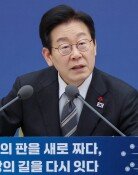Won-dollar exchange rate breaks through 1,300 won
Won-dollar exchange rate breaks through 1,300 won
Posted February. 23, 2023 07:44,
Updated February. 23, 2023 07:44
The prospect of the Fed’s prolonged austerity policy raises the “king dollar” specter again. The won-dollar exchange rate, which fell to 1,220 won earlier this month, soared above 1,300 won in just two months. As a result of a sharp decline in U.S. stocks by 2 percent on Wednesday, the Kospi also dropped more than 1 percent.
On Wednesday, the won-dollar exchange rate closed at 1,304.9 won, up 9.0 won from the day before. It is the first time since Dec. 19, 2022, when the exchange rate closed at 1,302.9 won, that the closing exchange rate exceeded 1,300 won again. The exchange rate started at 1,306.2 won, up 10.3 from the previous day, replacing the year’s highest figure. The exchange rate sharply increased 84.6 won in 14 trading days from 1,220.3 won on Feb. 2.
The depreciation of the won is attributable to the impact of the recent strong dollar caused by the concern that the Fed’s rate increases will continue longer than expected, as inflation does not seem to subside any time soon. At the same time, economic indices in employment, production, and consumption show signs of improvement.
S&P Global U.S. Composite PMI Output Index increased to 50.2 in February, reaching its highest level in eight months. Given that the PMI index greater than 50 means expansion, the Fed is likely to prolong tough austerity policy to curb inflation. Goldman Sachs chief economist Jan Hatzius wrote in a note to investors that it expects the Fed to raise interest rates three more times, in March, May, and June this year, by a quarter of a percentage point each.
The Chicago Mercantile Exchange (CME)’s Fedwatch, which forecasts the Fed’s monetary policy based on Fed Funds futures pricing data, saw a 73.8% chance of the Fed’s rate hikes for three consecutive meetings by 0.25 percentage points each, which will raise the U.S. benchmark interest rate to 5.25 to 5.50 percent. This is a sharp increase indeed, compared to just a month ago when it was around 3 percent. In light of St. Louis Fed President James Bullard’s comment that he would not rule out supporting a half-percentage-point interest-rate hike next month, the likelihood of the Fed’s rate hike in March by 0.5 percentage points has also increased to more than 20 percent.
Intensifying geopolitical risks are also fueling the dollar’s strength. The Russian invasion of Ukraine and the Chinese surveillance-balloon program have escalated the U.S.-Russia and U.S.-China conflicts, contributing to a higher demand for safe U.S. dollar assets.
Min-Woo Park minwoo@donga.com







